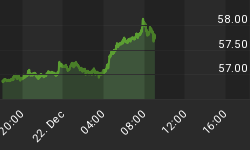Understanding the implications that business inventories have on the broader U.S. economy is a game of context. If you focus on the statistic in abstraction from longer term trends in the economy you can build a coherent argument that escalating inventories are auspicious in the immediate term. Contrarily, the same statistic situated within the proper long-term context emerges as less immediately promising. Since the former opinion is being trumpeted by The Street, it may be of some service to elucidate the latter opinion here.
The Toyota Lesson
In aiming to make the manufacturing process as efficient as possible, Toyota Canada does not keep more than a few hours worth of certain production materials on site. This type of 'just in time' inventory system can prove hazardous should there be some disruption within the transportation infrastructure, or even if trucks are delayed or packed improperly (i.e. with the product that is needed first being at the rear of the trailer). Nevertheless, the system usually works, and this is one of the reasons why the non unionized Toyota in Cambridge Ontario consistently ranks as one of the most efficient in North America.
With Toyota's perpetually increasing inventory efficiencies in mind - and realizing that similar systems are (have) being duplicated by not only automobile competitors but by companies in other industries as well - it is not surprising that U.S. business inventories have been trending lower for more than a decade. What has facilitated this change - often referred to as increased 'productivity' - is not necessary higher/faster inventory turnover, but better management of existing stocks. This is an important point to remember, especially since economists are touting that 'inventory rebuilding' will add significantly to U.S. GDP in the coming quarters.
The Not So Great Inventory Rebuilding Cycle
In an attempt to smooth out the imperfect statistic that is inventories, analysts often point to the inventory-to-sales ratio as being a more reliable forecasting tool. The logic touted is that the future implications of inventory levels can be better understood if you consider the trend of sales in relation to inventories - higher/lower inventories do not necessarily mean anything significant for the economy unless the trend in sales is also studied.
For the most part, the inventory-to-sales ratio has become standard fare. Accordingly, following this week's decline in September inventories (and a smaller decline in sales), the analysts came out of the woodwork to argue the significance of these dated statistics. Quoting just one of these analysts, the level headed Caroline Baum - in 'Shop in the Third Quarter, Produce in the Fourth' - we hear the standard line, one which sounds all too familiar:
Highlights:
-- Not only are inventories at an all-time low relative to sales, but accumulating them is also starting to make good business sense...
-- All-consumer-all-the-time isn't a necessary prerequisite to sustain economic growth...Inventories could easily make a positive contribution to GDP growth in the current quarter and in the first half of 2004...Come the second half of next year, however, "we'll need to have job growth" to sustain the expansion.
For those of you with a keen memory, you will recall that similar claims of an inventory rebuilding cycle were being touted in 2001 and 2002. To be sure, and as highlighted in a Feb 2002 Word on this site ("Deflating Inventory Mythos"), for more than a year the party line from the Fed - since March 2001 - had been:
"The associated backup in inventories has induced a rapid response in manufacturing output and, with spending having firmed a bit since last year, inventory adjustment appears to be well underway".
In March 2001 Sir Greenspan wasn't talking about inventories simply expanding. Rather, the Fed was giving a specific reason why the economy had slowed - slumping inventories - and was suggesting that a new inventory building phase was imminent. To be sure, in the two FOMC meetings following March 2001 the Fed included the statement "A significant reduction in excess inventories seems well advanced". And yes, at the time, bullish economists lapped it up.
When the inventory build up did not arrive in 2001 the Fed stopped mentioning inventories. That is, of course, until March 2002, when the Fed tried to assure the markets once again that inventories were going to build:
"The information that has become available since the last meeting of the Committee indicates that the economy, bolstered by a marked swing in inventory investment, is expanding at a significant pace." FOMC March 2002.
Suffice it to say, inventories did not build up with any sustained vigor in 2002.

Contradicting Common Sense?
As forklifts unload automotive parts at Toyota, many are dropped directly into the assembly line. The term 'storage' and/or 'inventories' doesn't exist...
With the inventory-to-sales ratio at record lows and the economy picking up steam inside of a low interest rate environment, a strong case can be made that inventories will be rebuilt in the coming months. Our viewpoint is not that this will not happen, but that the longer term trend of lower inventories puts this into a different, less bullish, context.
Beyond the seasonally adjusted chart - which shows inventories-to-sales at all time lows, consider two alternative charts. The first shows the data without its seasonal adjustment, and points out the yearly cycle of inventories - with the inventory-to-sales ratio always peaking in January/February - while the next shows the long-term trend smoothed out using a 6-month trailing sales number. Most notably, the second chart should be studied by Greenspan and any economist excited about the prospects of a huge inventory build up. To be sure, the trend - even when the economy was booming in the 1990s - is for companies to maintain lower inventories in relation to sales, and this trend will not be reversed. Perhaps when Greenspan and company are touting the next inventory building cycle they should remember that their 'productivity' driven economy precludes inventories from ever building up like they did in the past.

















